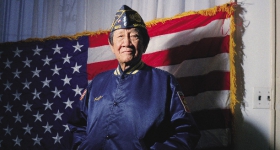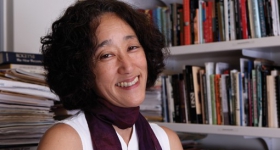Writer Catherine A. Traywick
Jane Sandoval can’t speak a lick of Tagalog — her parents made sure of that. “There’s no excuse for you to not speak well. You were born here,” her father used to tell his children, often punctuating this expectation with an adage gleaned from his own life as an emigrant from the Philippines: “There’s just too much competition.”
Today, at age 50, Sandoval is uniquely positioned to reflect on her late father’s credo. For the last 26 years, she’s worked as a nurse at San Francisco’s St. Luke’s Hospital, which has, for decades, teemed with Filipino nurses of all ages, backgrounds and dialects.
Yet their apparent success as white-collar professional belies their collective vulnerability. Since the 1980s, when hospitals began recruiting nurses in large numbers from the Philippines to alleviate US nursing shortages, Filipino nurses have earned less than their white peers, worked demanding or unpopular shifts and been disproportionately impacted by bad economies and other industry changes. Over the past few years, they’ve even become the target of English-only policies so far-reaching they might have shocked even Sandoval’s father.
Most recently, health care facilities from California to Maryland have allegedly targeted Filipino American nurses for suspension and termination, in an effort to quell dissension and curb worker solidarity. American-born nurses like Sandoval — who were once exempt from the exploitative labor practices imposed upon immigrant workers — are increasingly finding themselves locked in the crosshairs of anti-union animus as they band with their foreign-born counterparts.
Sandoval, ever reminded of her father’s struggles with discrimination and disparity, has positioned herself squarely in the center of this struggle, having worked her wat from affable emergency room nurse into vocal labor organizer — and she’s not alone.
Filipinos, once regarded as docile and disposable, are increasingly organizing for their rights within an industry that has, according to historians and sociologists, reaped its profits on gendered pay scales and ethnicity-based inequalities. So perhaps it was just a matter of time before the industry that gave them quarter began efforts to turn them out.
---
Long before Filipino nurses ever set foot in the United States, American nurses journeyed to the Philippines.
After the United States colonized the islands in 1898, American nurses descended on the country en masse and began establishing elite nursing schools as part a larger effort to, in the words of one nurse, “sanitize” the Filipino people. Later, as US demand for trained hospital workers increased, these schools evolved into a premier manufacturing site for foreign-trained nurses. By the 1950s, American hospitals were recruiting nurses from all over the Philippines.
“US hospitals, for the most part, exploited Filipino nurses,” said Catherine Ceniza Choy, a professor of Asian American studies at the University of California, Berkeley, and the author of Empire of Care: Nursing and Migration in Filipino American History.
“They were only being paid a stipend as opposed to a regular salary. They were supposed to get training, but many didn’t,” Choy said. “There is a larger collective experience of being vulnerable and exploited because of their immigrant status and because of their previous colonial status.”
By the 1980s, when Sandoval was graduating from St. Luke’s nursing program and beginning her career, US hospitals had fully realized the cost-cutting potential of hiring Philippines-trained nurses and began doing so in droves, at the expense of hiring unionized American nurses. Today, one in four employed Filipinas works as a nurse and, in California, Filipinos make up 18 percent of all nurses, despite being only 3 percent of the population.
“Hospitals wanted to change the pay model so they hired professionals from the Third World to basically break unions,” said Peter Chua, professor of sociology at San Jose State University and author of Ating Kalagayan: The Social and Economic Profile of U.S. Filipinos. “Initially, there was an assumption that if you recruit them, they’ll be subservient,” Chua said. “Their contracts are set, so why would they join unions?”
Today, many hospitals still recruit Philippines-trained nurses in an effort to keep wages low or otherwise cut costs. According to Chito Quijano, a CNA organizer, US medical facilities can get away with paying newly immigrated registered nurses (RNs) the wages of a nursing assistant, confident that the women won’t protest for fear of losing their work visa. This amounts to as little as $20,000 annually — $15,000 less than the average starting salary of an American registered nurse.
That wage gap doesn’t entirely disappear for Filipino American nurses, either — especially if they work in non-unionized facilities. Kuusela Hilo, an organizer with the United Nurses Association of California, said that non-unionized Filipino Americans disproportionately bear the consequences of understaffing and cost cutting. In one hospital she recently organized in Beverly Hills, CA, for example, the predominately Filipino nursing staff hadn’t had a raise in seven years.
Yet, as more nurses unionize, that dynamic is slowly changing. In 2008, RNs in Northern California — where a deep history of unionization drives wages up — earned on average $20,000 more per year than RNs in Southern California — where unions have yet to forge a stronghold.
Given these disparities, it’s becoming increasingly difficult for hospitals to keep even immigrant nurses from unionizing — especially as the line between “Filipino” and “American” has dissipated. That reality is at the center of Sandoval’s struggle. Once hailed as the solution to worker solidarity, Filipino nurses have become part of the “problem.”
---
St. Luke’s Hospital has an old heart. At its center, one can still walk through century-old hallways dressed in dark wood and carved stone, toward the original chapel and its antique reliquaries. Newer, less stately wings radiate to the left and right. The hospital’s latest addition is from 2008: an oversized placard facing Valencia Street that identifies the facility as the newest campus of the California Pacific Medical Center (CPMC), an affiliate of the health care giant Sutter Health.
As one of just two hospitals located south of Market Street — the stark dividing line between the city’s affluent, largely white neighborhoods and its working class communities of color — St. Luke’s mostly caters to San Francisco’s low-income, underinsured and uninsured residents. (By contrast, there are 10 hospitals located north of Market, four of which are owned by Sutter.)
Like the hospital itself, the nurses at St. Luke’s are a Mission District institution; many have worked there even longer than Sandoval and most have bonded over decades of service. They’ve been unionized for years. “There’s a sense of community. A feeling of staff ownership,” Sandoval said.
Since CPMC acquired the hospital four years ago, the nurses said things have changed for the worse. Instead of focusing on patient care, they’re attending hearings, organizing strikes and coordinating protests in an effort to keep CPMC from relocating the hospital’s services or closing its doors altogether. Now, they’re alleging that hospital managers retaliated against their efforts to organize by implementing an illegal hiring ban on Filipino nurses beginning in 2008 and persisting until today. Lending teeth to the complaint, the alleged ban coincided with a precipitous decline in the rate of Filipino hires — from 65 percent in 2007 to 10 percent in 2008, according to a joint investigation by the California Nurses Association (CNA) and the National Alliance for Filipino Concerns.
The St. Luke’s case is just one of many similar disputes recently brought forth by Filipino workers at health care facilities across the country. In 2008, 10 Filipino nurses made national headlines after their Smithtown, NY, employer, Avalon Gardens Rehabilitation and Health Care Center, filed retaliatory criminal charges against them after they went on strike. The nurses, who had been recruited from the Philippines in 2005, later told The New York Times that they had been overworked, grossly underpaid and “treated like dirt” for years.
More recently, in June 2010, four Filipino nurses were fired from the Bon Secours Health System of Baltimore, allegedly for speaking Tagalog during their breaks at work. Six months later, a group of 53 current and former Filipino health workers from the Delano Regional Medical Center in Delano, CA, filed a similar complaint with the Equal Employment Opportunity Commission, accusing hospital management of imposing an illegal and discriminatory English-only policy exclusively on Filipino employees.
Zenei Cortez, one of the presidents of the California Nurses Association, which is backing the St. Luke’s nurses in their fight, said the situation at St. Luke’s epitomizes the typical Filipino American nursing experience. As in most hospitals across the nation, Filipinos at St. Luke’s comprise a disproportionate share of the nursing force and are especially vulnerable during slow economies, management changes and hospital restructuring — all factors at play there.
When Sutter Health acquired St. Luke’s in 2007, it had little use for the chronically unprofitable hospital. The facility’s 220 beds, however, were a valuable asset to the company, which, according to a 2010 Bloomberg investigation, has spent the last several years buying a majority share of Northern California hospital beds, in an effort to increase its bargaining power with insurers.
Through a well-documented pattern of hospital takeovers and medical redlining — moving profitable services from low-income neighborhoods to more affluent ones — Sutter has gained control of 44 percent of the hospital beds in San Francisco, meaning that the company can essentially dictate the cost of health care. That leverage is, in part, why health care costs in Northern California are between 30 and 70 percent higher than in Southern California, according to health care analysts.
The company had planned to shutter St. Luke’s after laying claim to its beds, but was thwarted by the hospital’s tightly knit (and largely Filipino) nursing staff, who balked at the notion of leaving its community without accessible health care. Partnering with community groups and other victims of medical redlining, Sandoval and her fellow nurses organized two massive strikes against the health care giant, during which 5,000 workers walked out of 11 Sutter facilities.
Sutter eventually conceded — or, as Sandoval puts it: “Stayed our execution.” The company allowed St. Luke’s to remain open, but downscaled — shutting down a number of less profitable units, like the neonatal intensive care unit, while relocating others to more lucrative CPMC campuses.
For St. Luke’s nurses, that wasn’t the end of the struggle. Though Sutter incorporated St. Luke’s into the CPMC system, its nurses were still earning at least 25 percent less than their counterparts at other campuses, and Sutter executives refused to bring them to parity.
It’s a common problem for Filipinos, Chua said. “Filipinos tend to be underpaid, given the sort of educational background they have. Registered nurses tend to have high salaries, but when you actually look at the kinds of jobs they do, Filipino nurses tend to be working the night shifts, tend to be working overtime. So when you actually calculate it all, they actually earn less, relative to other workers.”
The disparity is linked to Filipino nurses’ history of being temporary and immigrant workers. Even after Filipino nurses became US residents, citizens and permanent employees, hospitals were reluctant to pay them as such. Consequently, their economic status failed to increase at the same rate as that of other nurses — an outcome that has persisted even as more US-born Filipinos enter the field.
By the beginning of 2008, however — when the alleged hiring ban purportedly went into effect — St. Luke’s nurses had put so much pressure on Sutter that, in addition to keeping the hospital open, they managed to win wage parity with the rest of CPMC’s nurses.
In other words, the nurses had become a thorn in the side of a notoriously anti-union company and — in Cortez’s opinion — they were about to pay for it.
---
While US hospitals have generally welcomed foreign nurses, that trend is dotted with dark exceptions. Norma Ruspian Watson, a skilled and ambitious young nurse who immigrated to the United States in 1973, experienced firsthand the industry’s shadow side when she began looking for a hospital job. Her skin color, it turned out, trumped her skill set. The first hospital she approached refused even to give her an employment application, explaining that the facility “does not hire brown-skinned Filipinas.”
Though not quite the norm, Watson’s experience was not uncommon. During the 1970s and 1980s, the American Nurses Association, one of the most influential nursing unions in the country, actively lobbied against the hiring and recruitment of Filipino nurses, because they feared that nursing migration would put white nurses out of work. Their efforts to quell the trend often capitalized on misconceptions that Filipino nurses were poorly educated and didn't speak English well, and prompted many hospitals to ban them altogether.
Luisa Blue, a registered nurse and the national president of the Asian Pacific American Labor Alliance, claims that such bans persist today, albeit surreptitiously. She explained that, while working in a facility in Miami several years ago, she witnessed an underthe- table hiring agreement: “A promise was made about ‘Don’t hire Filipino nurses,’ she said. "'Hire nurses from India because, after two years of getting acclimated to U.S. culture, Filipino nurses get mouthy.'"
Such incidents tend to go unreported by staff and overlooked by the public, which is why the St. Luke’s case is so unique. Not only have several nurses signed sworn statements testifying to the existence of a hiring ban, but the issue has also generated local and international media attention — not least because CPMC’s response to the allegations has played on many of the cultural stereotypes that, nurses say, prompted the ban to begin with.
Sandoval first caught wind of a hiring ban in the spring of 2008. Two of her supervisors, Ronald Rivera and Ron Villanueva (both Filipino Americans), told her that they had overheard CPMC’s vice president of nursing Diana Karner say something to the effect of: We should probably not hire anymore foreign graduate nurses, because it is hard to understand them and be understood by them. The supervisors allege that Karner was referring specifically to Filipinos, who composed the vast majority of St. Luke’s foreign-trained nurses.
The nail in the coffin, as far as Sandoval was concerned, was a later statement made by Chris Hanks, St. Luke’s director of critical care from 2008 to 2009. Hanks, who reported directly to Karner at the time, attested that she had told him: “The Filipinos are always related, or know each other, and that’s not good. You’re not to hire them.”
“One of the first people that brought this to CNA’s attention was not even a Filipino,” Sandoval said, referring to Hanks. “That’s key. These weren’t just Asians or Filipinos that were appalled. ”
Shortly afterwards, the rate of Filipino new hires dropped dramatically, according to employee rolls reviewed by CNA. According to CPMC, Hanks was “later fired for misuse of funds.”
CPMC, for its part, maintains that no ban ever existed and, while the company denies that Karner made the alleged statements, it concedes that, if she engaged in a conversation about foreign-trained nurses, it was in only light of “certain patient complaints (about the) the nurse’s ability to effectively communicate,” according to a public statement released by the company. The statement further acknowledges “there has been a preference at St. Luke’s for bi-lingual (Spanish-speaking) nurses.”
“The hospital is in the Mission. The patient population is 60 percent Latino. Our nurses at St. Luke’s are 66 percent Asian,” said Kevin McCormack, CPMC’s media relations manager. “We need to make sure that we have nurses who can not only be linguistically sensitive to the patients but also culturally sensitive.”
This particular justification of an incident that, according to CPMC, never even took place, riled Sandoval. Along with many Filipino nurses at the hospital, she doesn’t speak Tagalog, doesn’t have a foreign accent and — like most brown-skinned Filipinos with typically Spanish surnames — is mistaken for Latino often enough. “I grew up in the Mission District, near St. Luke’s, so I know what this community is made of. If the managers would work side by side with us for 10 minutes, they would see there is no cultural divide,” Sandoval said. In essence: Filipino nurses and their Latino patients have more in common than a shared history of Spanish colonization.
CPMC’s efforts to demonstrate the company’s cultural sensitivity didn’t stop there. Its CEO, Warren Browner, addressed the dispute on his personal blog. “If I take the accusation personally, there’s a good reason,” Browner wrote, further explaining that, as a medical student and intern, he developed a special rapport with a group of Filipino nurses at San Francisco General Hospital — even taking on extra shifts so that he could enjoy “lumpia at midnight” with them. The formative experience, he explained, instilled in him a deep respect for Filipinos and even informed his decision to spend a month in the Philippines after med school. He concluded:
“I never did garner the strength to try balut … but I did get to see the rice terraces of Sagada and the white sand beaches of the outer islands. To this day I regret not buying a hand-carved chess set from a remarkable man in Banawe who had been in Apocalypse Now, which was filmed in the Philippines.”
The post sparked an intense ire in the Filipino American community. The San Francisco-based Filipino Community Center (FCC) released a statement calling Browner’s comments voyeuristic, an insult to injury and ultimately irrelevant.
“It’s like saying, ‘I can’t be racist, because some of my best friends are black,’ ” said Raquel Redondiez, vice chair of the Filipina advocacy group Gabriela USA. “It demonstrated how unsophisticated their understanding is of power dynamics, of race — even dynamics within a corporate organization.”
Browner subsequently removed the post, but the damage was done. Numerous Filipino advocacy groups quickly joined the fray, recasting the case as a Filipino community issue, rather than simply a labor dispute.
Soon both local and foreign media were covering the issue, and Philippines-based news correspondents scrambled for exclusive interviews with Sandoval, the fast-talking, English-speaking underdog.
In the face of the media blitz, CPMC went on the offensive, claiming that the CNA union had fabricated the allegations to cover up its own failure to win a contract. “We offered the nurses a 21 percent pay increase … and a whole host of other things that most people would think was amazing,” McCormack said, “But the unionists … got in the way.” He cedes, however, that the proposed pay increase would not have brought the nurses to parity with other campuses. When CNA insisted on equal pay, the company reduced the offer to 2 percent. Since then, CNA has won parity for St. Luke’s nurses.
McCormack further contends that CNA’s allegations are an attempt to embarrass CPMC into allowing the union to organize the company’s newest hospital — which is intended “to open up as a non-CNA facility.” The union’s interest in the new hospital, he argued, is money — potentially $1,000 in dues from every new nurse that joins the union.
It’s an interesting counter-allegation, especially given CPMC’s reputation as a union buster.
“Hospital chains will spend millions of dollars to mount an anti-union campaign,” Luisa Blue said. “Sutter Health Systems is one of the most anti-union health care systems in the country. … They’re notorious — it’s that kind of company.”
By all accounts, CPMC stands to lose much more money from unionization than CNA could hope to gain and that, Cortez said, is the crux of the issue. St. Luke’s vocal nursing staff and its pesky union are costing CPMC a lot of money, as well as sending a “bad message” to the other non-unionized campuses. The fact that the agitators are predominately Filipinos, who, in Karner’s purported words, “are always related or know each other,” makes them an easy target for retaliation.
When this article went to press, an investigation of the case was pending by the San Francisco Commission on Human Rights, and the nurses at St. Luke’s remained in deadlock with CPMC management. While the nurses and their union hold out for a public admission of guilt and the right to organize nurses at other CPMC campuses, CPMC is adamant about keeping CNA out of its other facilities.
“They’re not taking this as seriously as we are,” Cortez said. “They think we’ll get tired and go away, but we won’t. We’ll persist.”
Catherine A. Traywick is a contributing editor at Hyphen. This story was funded in part by the Spot.us community.
Correction: A version of this article published on November 8, 2011
incorrectly described Chito Quijano as a union organizer with the United
Nurses Association of California. It has been changed to correctly
state that Quijano is a union organizer with the California Nurses
Association. Zenei Cortez's title has also been updated to reflect her
new position as one of four CNA presidents.










Comments